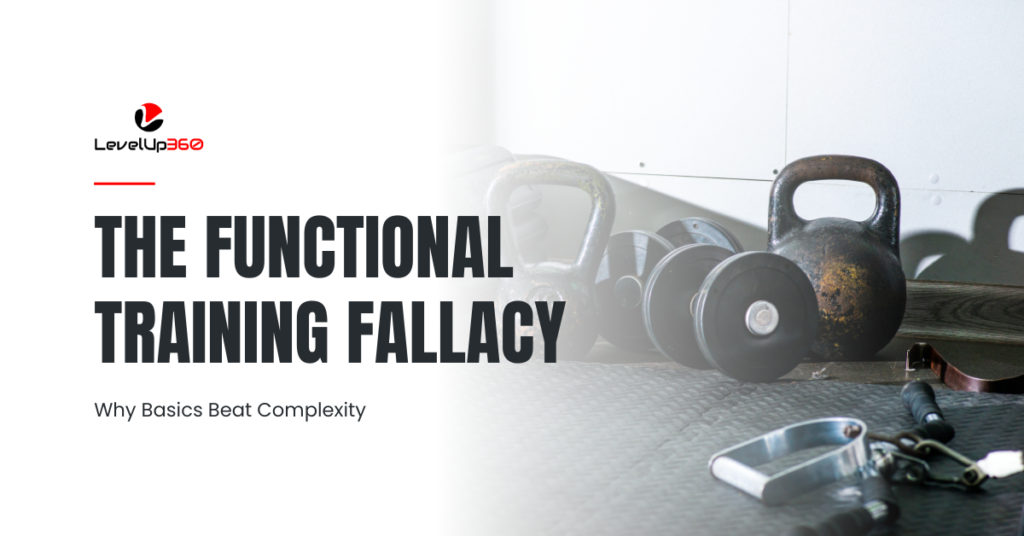
The Functional Training Fallacy: Why Basics Beat Complexity
Imagine yourself years from now. Will your body ache doing everyday activities you love?
When your friends invite you on a ski trip, will your knees ache with each turn down the slopes? Or will your back suddenly spasm while gardening as you lift a bag of soil?
We all want to retain strength and mobility into our later years so we can remain active in the activities we enjoy. But this requires diligent training now to build an enduring physical foundation.
Enter “functional training” – the fitness craze promising balanced, coordinated strength instantly transferable to real life. By now you’ve likely seen funky functional equipment at your gym. Things like:
- Bosu balls that wobble under your feet
- TRX suspension trainers dangling from the ceiling
- An array of medicine balls and kettlebells
- Foam rollers and balance boards
Walking through any commercial gym, you’ll find these items clustered together in a space bearing the label “Functional Zone”. You may also see group classes advertised as “Functional Strength Training”.
Chasing the latest fitness fad can leave you frustrated and no closer to your goals. The most reliable way to build strength that translates to life is simple - focus on progressive overload using foundational movements
The Exercises In Functional Programs
The exercises used in functional training aim to improve physical competence in everyday tasks through integrated, multi-plane movements and reaction drills.
You’ll see things like:
- Core isolation moves like planks, Pallof presses, and dead bugs
- Using unstable surfaces like bosu balls and foam rollers
- Multi-joint movements through different planes of motion
- Single-leg and single-arm exercises
- Reactive drills with medicine balls and verbal cues
This all sounds impressive in theory. But here’s the million-dollar question:
What makes these exercises inherently more “functional” than a simple barbell squat or deadlift?
When you scrutinise the underlying principles, several flaws emerge. Let’s examine three pervasive myths behind this functional fitness trend.
The Flawed Theories Behind Functional Training
Myth 1: Isolated Core Exercises Uniquely Build Functional Stability
Many functional programs emphasize core isolation movements like planks, birddogs, and ab rollouts. However, studies demonstrate heavy compound lifts like deadlifts, squats, and presses build true spinal stability better.
Why? Your core must generate sufficient muscular force to stabilize your spine against heavy external loads. The progressive overload from compound lifts forces core strength to continually increase like roots growing deeper to anchor a rising tree.
For structural integrity under load, heavy deadlifts are far superior to endless crunches. Don’t let the core buzzword fool you – go heavy on big lifts.
Myth 2: Unstable Surfaces Enhance Balance and Motor Control
A staple of functional training is performing exercises on physio balls, wobble boards, and foam rollers to supposedly enhance balance, proprioception, and coordination.
However, the principles of specificity and progressive overload disagree. Loads must be lighter on unstable surfaces to maintain control, limiting progressive overload over time.
In fact, studies show force output decreases a whopping 30-70% during exercises on unstable surfaces! And adaptations are specific – just because you can balance on a BOSU doesn’t mean you’ve enhanced real-world coordination.
For a stable strength foundation, stick to progressive barbell training built on a steady surface. Leave the circus tricks to performers.
Myth 3: Multi-Plane and Unilateral Training Transfers Better to Real-Life
Functional training also employs a lot of multi-plane, multi-joint exercises like a lunge with rotational press. The thinking is these patterns better prepare you for real-life demands compared to a bilateral lift like a squat.
This sounds logical until you think deeper. While specificity matters in sports, everyday competence requires whole-body strength. For example, to lift and carry a suitcase, you strengthen the whole body with compound lifts rather than specifically training with a suitcase.
In most cases, heavier loads are required to drive increases in overall strength over time. Chasing novelty risks overshadowing principle-based progress.
While variety prevents stagnation, don’t confuse novelty with progress. Master the basics before getting creative.
The Evidence: Science Doesn’t Support Functional Claims
So beyond theory, does research actually indicate functional training transfers better to real-world settings? Let’s look at what science says.
A 2017 study had athletes train using stable machines vs unstable machines. After 6 weeks, both groups improved equally in strength, power, speed, and jump height.
Likewise, a 2016 review found no differences in motor control or pain reduction between functional exercises and traditional strength training. Both methodologies worked similarly.
The data fails to demonstrate the clear advantages of unstable or multi-plane movements over simple barbell training for the average person. Everyday function depends on progressive overload – not needless complexity.
The True Allure of Functional Training

If the evidence doesn’t support it, why is functional training so popular? Let’s scrutinise the real reasons it’s so seductive yet deceptive for many people.
Reason 1: Accessibility for Beginners
Functional training relies heavily on easy-to-perform bodyweight movements. This makes it accessible from home with no gym or equipment required. Beginners aren’t intimidated starting with basic bodyweight drills.
But this accessibility is also functional training’s greatest limitation. Although useful for establishing baseline competence, mastering push-ups and planks fails to drive major strength gains compared to progressively overloading barbells.
Once you’ve built a movement foundation, you must specialize your training to continue progressing. Chasing new exercises without focused overload stalls results. The generality of functional training is better for starting fitness than sustaining it.
Reason 2: It Appears To Mimic Real-World Demands
At first glance, unstable surface training and multi-plane movements seem to mimic real-life challenges better than a straightforward barbell squat. But the science disagrees.
Performance on an unstable surface doesn’t directly transfer to stable environments where most daily activity occurs. Likewise, asymmetric exercises often use lighter loads than bilateral lifts, limiting strength development.
Appearances can be deceiving. Yoga on a BOSU ball resembles balancing on uneven terrain but builds different physical skills. Focused barbell training adheres closer to principles of specificity and progressive overload for everyday function.
Reason 3: It’s Marketed As The Superior Approach
Functional training is packaged and branded as an evolution from outdated strength training. But it significantly overlaps with traditional methodology that has worked for decades.
There’s no universally accepted definition for what constitutes a “non-functional” exercise. Squats, deadlifts, and presses build full-body strength that transfers broadly to everyday activity.
The rhetoric surrounding functional training aims more to market it as novel and advanced rather than reflect exercise science principles.
The Practical Implications
For the average person seeking sustainable everyday mobility, traditional progressive barbell training stands the test of time. Fancy functional tools likely aren’t needed.
Mastering squats, deadlifts, presses, and pulls delivers the broad strength foundation that supports mobility across the decades. Focus on nailing the basics before getting fancy.
This isn’t to say you can never try new exercises or equipment. Variety prevents stagnation when used judiciously. But avoid needless complexity that overshadows consistency and overload.
Here are three key questions to ask yourself when considering a new “functional” exercise:
- Will this drive substantially more progress than a basic lift?
- Does the injury risk outweigh any potential benefit?
- Is this the most effective use of my time and energy for my goals?
For sustainable everyday strength across the years, uncomplicated training wins out. Forget complexity for its own sake. Get back to tried-and-true strength training basics.
The Bottom Line
Chasing the latest fitness fad can leave you frustrated and no closer to your goals. The most reliable way to build strength that translates to life is simple – focus on progressive overload using foundational movements.
Consistency over time trumps constant complexity. Forget fancy functional exercises. Prioritise mastery of traditional strength training exercises – the “boring” basics that work.
Recommended reading
Recommended reading
Additional Resources
Feeling in control of your health
If you are interested in improving your health and wellness, check out other resources such as Our Blog, Free Resources and/or join our private Body-Mind Transformation Secrets Community on Facebook, and go on an even deeper dive with me to uncover how to succeed in your health and wellness goals.
You may also be interested in our Sleep Secrets Cheat Sheet. It is a great resource with strategies to fix and optimize your sleep which is crucial to succeeding in your health and wellness goals.
Resources
Pictures








